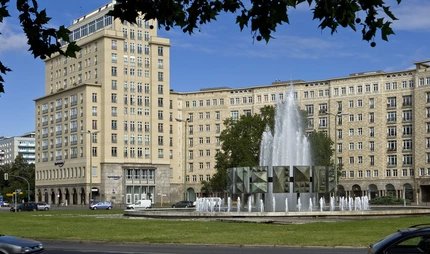
Romantic villas and modern housing
Architecture through the ages
Take a walk through Berlin’s architectural history in Steglitz-Zehlendorf. The borough’s buildings tell the whole story: from romantic palaces to magnificent patrician villas to the breakthrough of modern architecture, .
Pure romance – Schloss Glienicke and Pfaueninsel
The architectural voyage of discovery begins in the far south of Berlin – almost in Potsdam.
Prussia’s kings knew the best places in their city. In the south of Berlin and in Potsdam they built a cultural landscape of parks and palaces of particular beauty and harmony. No wonder that they are a UNESCO world heritage site.
You can also include a trip to Italy: Schloss Glienicke is inspired by Italian design.The view from the park sweeps far across the Havel to Potsdam. And for especially romantic excursions you can go to Pfaueninsel with its little palace. A ferry takes you to the island, where peacocks are free to strut around and display their beautiful plumage.
Hidden deep in the dark forest is Jagdschloss Grunewald, the oldest palace in Berlin. It houses works by Lucas Cranach and the oldest
Renaissance palace hall in Berlin.
Villas, castles and palaces in Lichterfelde West
Wealthy Berliners achieved the dream of living close to Berlin but in leafy surroundings when the Lichterfelde West villa colony was built in the second half of the 19th century. A stroll through the area takes you past Tuscan villas, Tudor palaces with merlons and turrets, and English country houses.
Squaring the circle: modern residential architecture
Instead of looking back to past architectural styles, the Bruno-Taut-Siedlung in Zehlendorf is an example of the modern housing estates that arose the 1920s, designed to emphasise light and space. The Bruno-Taut-Siedlung was built between 1926 and 1932 in the plain and simple Bauhaus style. The colourful façades of the complex led to the nickname Papageiensiedlung, or ‘Parrot Estate’.
In the Nikolassee district after the war, the Schlachtensee student accommodation was built. It is a fascinating example of post-war Modernism, whose colourful and asymmetric design reflects the desire for individuality within the community.
A particularly striking example of 1970s architecture is the Bierpinsel on Schloßstraße in Steglitz. For decades, the once red but now multicoloured tower block with its outlandish ‘paintbrush’ shape contained restaurants and pubs. The building has been closed for the past ten years, but there are still hopes that one day the beer will flow again in the Bierpinsel.
The Berlin Brain
The Humanities building of the nearby Free University of Berlin in Dahlem is also worth a look. It was built in the 1970s and designed as a decentralised, adaptable building with many courtyards where students from all disciplines could meet and exchange ideas. Unfortunately, the cladding was not up to the Berlin weather and started to rust, earning it the nickname Rostlaube, the ‘Rust Lodge’. It was followed by the shiny new Silberlaube, or ‘Silver Lodge’, when star architect Lord Norman Foster, who also designed the dome on the Reichstag, built the new Philological Library for the FU Berlin. In the middle of the campus, a dome now rises above the futuristic library, known as the Berlin Brain. It’s almost a surprise to see that there are still books made of paper and cardboard on the shelves.
Find out more about the city’s neighbourhoods with our Going Local Berlin app.







